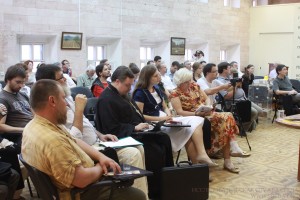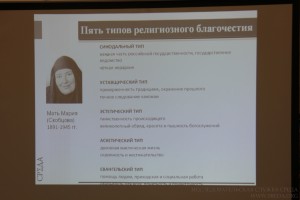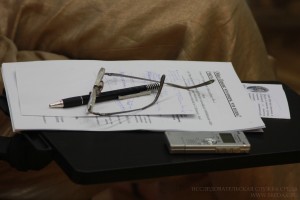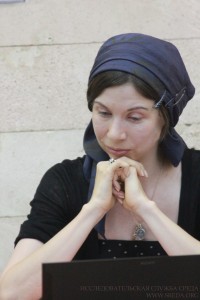The image of Russian Orthodox Church
Дата публикации: 07/06/2013 On July 4, 2013 at the Russian Orthodox University, coordinator of the research organization Sreda, Alina Bagrina, presented the results of a nationwide representative survey of 1,500 Russians (fieldwork: FOM-Penta, 2012) and a survey of 135 participants of the Orthodox media festival “Faith and the Word” (members of the diocesan press service and Orthodox media, 2012) which focused on the perception of the current and desired images of the Russian Orthodox Church. The presentation ended with a discussion between experts.
On July 4, 2013 at the Russian Orthodox University, coordinator of the research organization Sreda, Alina Bagrina, presented the results of a nationwide representative survey of 1,500 Russians (fieldwork: FOM-Penta, 2012) and a survey of 135 participants of the Orthodox media festival “Faith and the Word” (members of the diocesan press service and Orthodox media, 2012) which focused on the perception of the current and desired images of the Russian Orthodox Church. The presentation ended with a discussion between experts.
DESCRIPTION OF THE SURVEY
The idea of studying public perception of the image of the Russian Orthodox Church was inspired by the work of Mother Mary (Skobtsova) in “Types of Religious Life” (1937). Her five types of piety seem to be relevant in the present. They are: synodal (St. Petersburg), ritualist (Moscow, the capital of the principality of Moscow), aesthetical (Byzantium), ascetical (monasticism, the early days of Christianity), and evangelical. While preparing the questionnaire, each type was classified by two characteristics, which gave a list of ten characteristics. In addition, an extra set of frequently mentioned characteristics was added, based on our experience of studying the perception of the Church, received at church events and from expert audiences. Finally, we formed a list of twelve additional options. As a result, respondents were offered a list with 22 possible characteristics of the Church:
1. An important part of the Russian state, a government agency
2. Clear hierarchy
3. Adheres to tradition, guards the past
4. Strict adherence to canons
5. Mystery of what is happening
6. Magnificence in ceremony, beauty and splendor of worship
7. Mystical spiritual life
8. Modest and not tied to possessions
9. Helps people, parochial and social work
10. Open to all, clear and friendly
11. Actively involved in the upbringing of children and youth
12. Willing to change
13. An alternative to the market economy and the consumer values
14. Has spiritual authority, morally assesses events
15. Active stance on political issues
16. International Orthodox mission
17. Extensive presence in the media
18. Invisible, has a lack of public activity
19. Wealthy
20. Factious, the ministers of the Church may have distinct views
21. Coherence, cohesion, and submission to the Patriarch
22. Willing to engage in dialogue with representatives of other religions, and Christian denominations
In the course of the research, respondents were asked to select up to 5-characteristics and answer the following questions:
1. “Which characteristics, in your opinion, are most relevant to the Russian Orthodox Church at the present time?”
2. “Which characteristics would you like to see in the Russian Orthodox Church in the future?”
OVERALL RESULTS
Among all respondents, 22% had difficulty choosing the current characteristics of the Church’s image. 26% had difficulty describing the desired image. Therefore, nearly four-fifths of Russians are familiar with the Russian Orthodox Church, and three-quarters of Russians have expectations of it.
The five most popular characteristics of the existing image of the Church, according to the results of the national survey are:
1. Adheres to tradition, guards the past (30%)
2. Helps people, parochial and social work (30%)
3. Magnificence in ceremony, beauty and splendor of worship (22%)
4. Open to all, clear and friendly (21%)
5. An important part of the Russian state, a government agency (17%)
The five least popular features of the current image of the Church:
1. An alternative to the market economy (2%)
2. Invisible (2%)
3. An active position on political issues (4%)
4. Factious (5%)
5. Mystical spiritual life (5%) / willingness to change (5%)
The five most desired characteristics of the image of the Church, according to the results of the national survey:
1. Helps people (38%)
2. Open, clear and friendly (31%)
3. Active in the upbringing of young people (26%)
4. Modest and not tied to possessions (22%)
5. Adheres to tradition, guards of the past (18%)
Five of the least desirable characteristics of the image of the Church:
1. Wealth (2%) / factious (2%)
2. Mystical spiritual life (3%)
3. An alternative to the market economy and consumer values (5%)
4. A clear hierarchy (6%)
5. Magnificence in ceremony, beauty and splendor of worship (7%)
It may be noted that the difference between current and desired characteristics is not very large. Many of the characteristics of the Church’s image are current and also desirable. In terms of percentages, there are no sharp differences.
Two characteristics are missing:
• Magnificence in ceremony, beauty and splendor of worship
• An important part of the Russian state
Added:
• Modest and not tied to possessions
• Active in the upbringing of youth
Remained:
• Help people (increased response)
• Open, clear and friendly (increased response)
• Adheres to tradition, the guards the past (response was weaker, dropped from first to fifth place)
According to the survey, of the five types of piety, the current image of the Church is best identified with Evangelical. And, this type is the most requested (to help people and to be open). At the same time, the congregation (attending worship services once a month or more – 8% of Russians), identify the current image of the Church, as Ritualist, while speaking about the current image of the church, and they wouldn’t like to see it as such in the future.
It is interesting that such a specific group of respondents – members of the Diocesan press services who participated in “Faith and the Word” festival – made the maximum possible requests in respect to the Ascetic type of piety (a mystical spiritual life and not tied to possessions).
MOST AND LEAST SENSITIVE CHARACTERISTICS
As the nationwide survey showed, the greatest difference between the desired and current image of the church is drawn to these characteristics:
• “Modest and not tied to possessions” (10% see it now and 23% would like to see a modest church in the future)
• “Active in the upbringing of children and young people” (13% now and 23% in the future)
• “Openness” (21% and 31%)
• “Helping people” (30% and 38%)
At the same time, the positions of “Adhering to traditions” (30% now and 12% requested) and “Magnificence in ceremony” (22% now and 7% requested) are the most “over-fulfilled” and requests to see them is minimal.
The “coldest” features are:
1. “A mystical spiritual life” (5% see it in the Church, 2% want to see it)
2. “An active position on political issues” (4% now and 5% request)
3. “Invisible” (2% now and 2% request)
4. “Factious” (5% now and 2% request)
5. “Coherence” (6% now and 8% of requests).
According to these parameters there are minimal differences, which indicates indifference by the Russians in regard to these options.
CONGREGATION
If you distinguish from the respondents the group of parishioners – respondents who attend worship services once a month or more (8%) – then the current image of the Church, as compared with the “Russians in general”, loses such features as “magnificence in ceremony, the beauty and splendor worship” and “an important part of the Russian state”:
1. Adheres to tradition, guards the past (47%, “Russians in general” – 30%)
2. Helps people, through parochial and through social work (44%, Russia 30%)
3. Strict adherence to the canons (29%, Russia 16%)
4. Open to all, clear and friendly (28%, Russia 21%)
5. A clear hierarchy (21%, Russia 11%)
On the other hand, all five of the desired characteristics of the Church named by the congregation reflect the opinion of Russians in general; furthermore, the order of priorities preserves while “urgent requests” differ:
1. Helping people, parochial and social work (47%, Russia 38%)
2. Open to all, clear and friendly (38%, Russia 28%)
3. Active in the upbringing of children and young people (38%, 26% RF)
4. Modest and not tied to possessions (31%, Russia 23%)
5. Adheres to tradition, guards the past (23%, Russia 18%)
FINDING: DO RUSSIANS NEED A “USEFUL CHURCH”?
When comparing the “expressed” and “unexpressed” (missing or under-represented characteristics in the desired image of the Church) it becomes apparent, that this image is sufficiently secular. Desired characteristics are visible, external, and useful. The church seems to solve external social problems. Spiritual and mystical life of the Church, strong hierarchy, and being an alternative to the market – have no significance in the eyes of the Russians. This applies not only to the opinion of Russians in general, but also to the opinion of the parishioners. Incidentally, this trend of utility, “utilitarian religion”, is also found in the global context (modern religion).
EMPLOYEES OF THE DIOCESAN MEDIA OFFICE
According to their answers they have a few discrepancies with the responses of Russians in general and parishioners. As such, when describing the current image of the Church, they place in first place not the adherence to the traditions, but spiritual authority (55%). Incidentally, the current image of this position corresponds to the desired (51%). The greatest difference is observed on the characteristic of “Open to all”: this was identified as a current image by 10% of respondents, and 48% would like to see it. It is extremely important for the employees of the dioceses to have a Church that is modest and not tied to possessions (1% now and 30% request).
EMPLOYEES OF THE ORTHODOX MEDIA
Like the Russians in general and parishioners, in describing the current image of the Church, adherence to tradition (49%) is placed in first. In second, following with the employees of the diocesan offices is spiritual authority (46%). Members of the Orthodox Media include in the five main features of the Church a mystical spiritual life (43%) and a clear hierarchy (29%); it differs them from the other groups of respondents. The largest requests (i.e., the maximum difference between the desired and actual) Orthodox journalists, as well as the employees of the dioceses, give to the positions of “Openness” (6% now, and request 51%) and “modesty” (0% vs. 30%).
GROUPS OF FAITHS
For Muslims, the main request addressed to the Church is a willingness to engage in dialogue with representatives of other religions, for the unbelievers – invisible and subordinate to the Patriarch. Orthodox Christians, who regard themselves to be a part of the Church, are more likely to want to see it open and helping people.
WEALTH
9% of Russians in general mark wealth as a current characteristic of the Church, and 2% would like to see it in the future. Thus, wealth is perceived and is an undesirable characteristic. The negative attitude to the wealth of the Church is common among Russians who regularly use the Internet, as well as students, residents of the North-West, South and North-Caucasus countries and Orthodox who do not consider themselves part of the Russian Orthodox Church. In contrast, the wealthiest Russians are relatively neutral to the well-being of the church, including professionals in the field of science, culture and art, and the parishioners.
CHURCH SEEN BY MEDIA AUDITORIUM
We analyzed the perception of the image of the Church through the eyes of four media audiences: the Internet (“Every day (almost every day) I use the Internet” – 30%), Print-audience (“Every day (almost every day), I read newspapers and magazines” – 37%), the TV audience (“Every day (almost every day) I watch TV” – 76%) and Radio audience (“Every day (almost every day), I listen to the radio” – 28%).
Internet audience
Internet users are people of a young age, high wealth, high opposition and a low level of trust, and are the most indifferent in regard to the Church. They are somewhat more likely (compared to the average Russian) to see the Church committed to tradition, with a clear hierarchy and presence in the media. They want to see the church ready for dialogue with representatives of other denominations and faiths, open to change and do not particularly want to see it rich.
Print audience
People in this audience are most commonly women, middle-aged, and a larger number of non-believers. In this audience, a lot of people have higher education. They are attentive to the Church and in their evaluations tend to go to extremes, demonstrating both maximum negative and maximum positive attitudes. They are much more likely to say that the Church is helping people and is actively involved in the upbringing of young people, and less likely to mention the splendor of the ceremony. However, they rarely look to other Churches to follow the traditions and safeguard the past, and would like more openness and clarity.
TV audience
This audience consists of people who are a little older than average, are trustful of authorities, are Orthodox, and see themselves as part of the Russian Orthodox Church. They are less likely to say that the Church is rich and is part of the Russian state.
Radio audience
These are people of older ages and are slightly more commonly Muslims; in addition, it is the most religious audience. From the Church, they want moral evaluation of events and active participation in the upbringing of children.
Photo: Maria Kuzmichova




